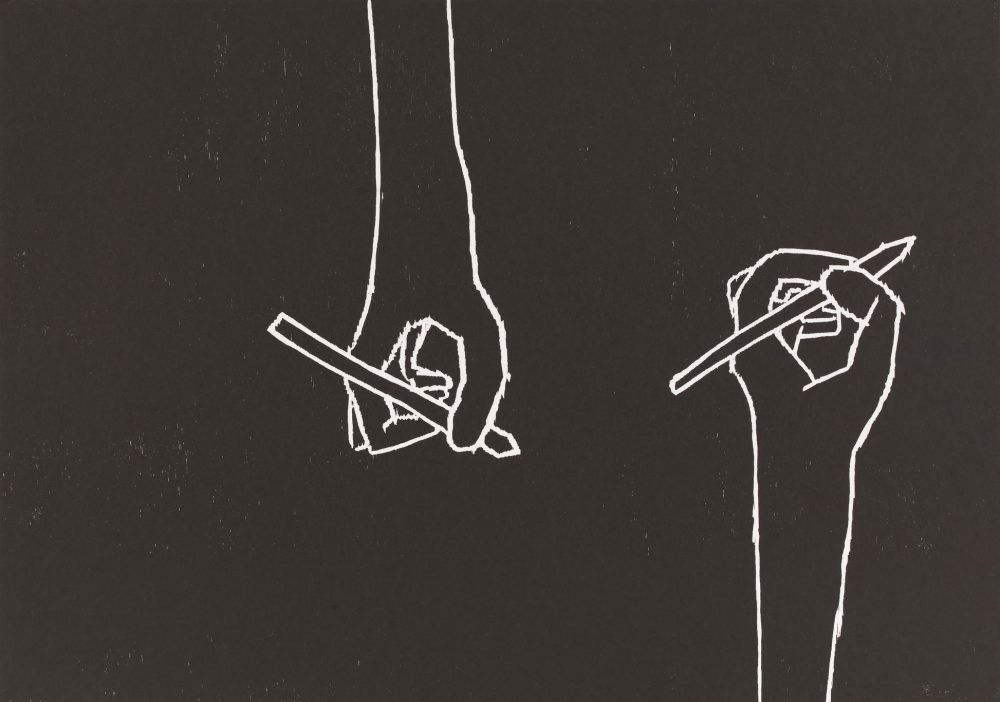The Future of Arts Criticism: Part 1
Art Review contributors share their thoughts on the future of critical arts writing in New Orleans.

David Shrigley, Untitled (Hands writing), 2008. Woodcut print. Collection of the Museum of Modern Art, New York.
Editor's Note
Pelican Bomb’s staff is small, and we wouldn’t be anywhere without the hard work of our Art Review contributors. Since 2011, our base of writers has grown exponentially, including seasoned art critics, creative-nonfiction writers, and arts administrators of all stripes. While Pelican Bomb is closing, we hope that our contributors will keep up the conversations they’ve begun, writing about contemporary art in New Orleans for local, regional, and national publications. We asked a few of Pelican Bomb’s writers to reflect on the future of arts writing in the city. Taylor Murrow and Benjamin Morris, who both published their first pieces with us in June 2011, share their thoughts below.
Art is for everyone, not just academics, not just auctioneers or wealthy collectors. If there’s anything I am certain of these days, it’s that the importance of art cannot be overstated. Art is a window for all of us to view and discern and question the surrounding world. Art uncovers what has been buried by societies before us. It retaliates against oppressors. Art provides a path forward.
And art criticism can help us find that path. It can help peel back the skin and expose the raw fruit inside. How can New Orleans encourage a conversation around art with its citizens? For one, it can continue to blow the dust off old institutions and invite new perspectives inside. Those in power can give megaphones to marginalized voices that have been quieted in the past. Some of the monuments have come down, but what’s next? We’re at a pivotal moment in our culture, when we can choose which symbols will represent us and which structures will lead us forward. Art encourages us to take control of the narrative and decide which stories will be left behind for future generations.
—Taylor Murrow
Because you never know. Walking into a shotgun-turned-art space, or cruising down a street laden with galleries. Turning a corner in a museum corridor, or treading cautiously into a giant black box. Trailing a wailing calliope on the banks of the Mississippi. Encountering novel spirits in the depths of the coastal woods. Exploring this artistic landscape, you never know what you’re going to find. To sense. To behold. You never know what you’re about to discover.
In a city as culturally vibrant as ours, few joys rival heading out of the house en route to a show, for that simple reason: You never know what you’re about to see. Our many rituals—Second Saturday, the Linen Nights, Art for Art’s Sake, Prospect New Orleans—give us regular doses of the new and unexpected, the strange and the heretofore undreamed. To strap on our sandals and suspend our expectations, to privilege surprise and possibility over jaded ennui: As a critic, this is catnip, but as a citizen, it is confirmation that the arts are not merely cosmetic, but the lifeblood of where we live.
To my mind, the best criticism subsumes the self, elevates the work rather than its appraiser. As critics we try, we fail, we fail again, we fail better. But in reflecting on the future of arts writing in this city, the city where the spirit of discovery defines us, my greatest hope is that we always ask one question when we convene. Writer, artist, advocate, peer—what have you discovered lately? How did it challenge you, and how are you changed? Tell me, friend: What new out there have you seen?
—Benjamin Morris
Editor's Note
Check back next week for more contributors’ thoughts about art criticism in New Orleans.



